- With standard equipment
- With safety pack
Find more information in the General Comments section of the assessment
Find more information in the Rating Validity tab of the assessment
- See More
- See More
- See More
- See More
- Good
- Adequate
- Marginal
- Weak
- Poor
 Passenger
Passenger
 Driver
Driver
 Rear Passenger
Rear Passenger
 Driver
Driver
 Car
Car
 Pole
Pole
 Rear Seat
Rear Seat
 Front Seat
Front Seat
- Good
- Adequate
- Marginal
- Weak
- Poor
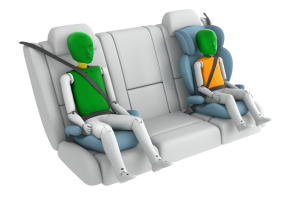
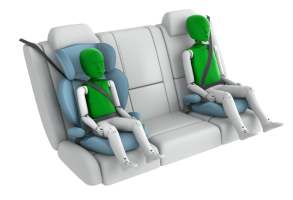
Passenger
outboard
center
Fitted to the vehicle as standard
Not fitted to the test vehicle but available as option
Not Available
-
i-Size CRS
-
ISOFIX CRS
-
Universal Belted CRS
Easy
Difficult
Safety critical
Not allowed
| Seat Position | ||||
|---|---|---|---|---|
| Front | 2nd row | |||
| Passenger | Left | center | Right | |
| Maxi Cosi 2way Pearl & 2wayFix (rearward) (iSize) | ||||
| Maxi Cosi 2way Pearl & 2wayFix (forward) (iSize) | ||||
| BeSafe iZi Kid X2 i-Size (iSize) | ||||
| Maxi Cosi Cabriofix & FamilyFix (ISOFIX) | ||||
| BeSafe iZi Kid X4 ISOfix (ISOFIX) | ||||
| Britax Römer Duo Plus (ISOFIX) | ||||
| Britax Römer KidFix XP (ISOFIX) | ||||
| Maxi Cosi Cabriofix (Belt) | ||||
| Maxi Cosi Cabriofix & EasyBase2 (Belt) | ||||
| Britax Römer King II LS (Belt) | ||||
| Britax Römer KidFix XP (Belt) | ||||
Easy
Difficult
Safety critical
Not allowed
In the frontal offset test, protection of the 10 year dummy was good or adequate. Dummy readings of chest deceleration in the 6 year dummy indicated marginal protection. In the side barrier test, both dummies were well protected and maximum points were scored. The front passenger airbag can be disabled to allow a rearward-facing child restraint to be used in that seating position. Clear information is provided to the driver regarding the status of the airbag and the system was rewarded. All of the restraints for which the i30 is designed could be properly installed and accommodated.
- Good
- Adequate
- Marginal
- Weak
- Poor

Head Impact 15.3 Pts
Pelvis Impact 5.8 Pts
Leg Impact 6.0 Pts
The bonnet surface provided good or adequate protection to the head of a struck pedestrian but performance was weak and poor in tests around the windscreen pillars. The protection provided to pedestrians' legs by the bumper was good at all test locations. Protection of the pelvis was also predominantly good. An autonomous emergency braking system which detects pedestrians is available as an option but was not assessed as part of this rating as it is not standard equipment.
- Good
- Adequate
- Marginal
- Weak
- Poor
| System Name | SAS |
| Speed Limit Information Function | N/A |
| Warning Function | Manually set |
| Speed Limitation Function | Manually set (accurate to 10km/h) |
| Applies To | All seats | ||
| Warning | Driver Seat | Front Passenger(s) | Rear Passenger(s) |
| Visual | |||
| Audible | |||
|
|||
| System Name | Lane Keeping Assist System |
| Type | Lane Keep Assist |
| Operational From | 50 km/h |
| Warning | Audible and Visual |
| Performance | |
|
LKA Confirmation Test
|
Pass (5/5) |
| System Name | AEB | |||
| Type | Forward Collision Warning with Auto-Brake | |||
| Operational From | 10 km/h | |||
| Additional Information | Default On | |||
| Performance | | ||||
| Autobrake Function Only | Driver reacts to warning | |||
| Operational Speed | 10-175 km/h | 10-175 km/h | ||
| Approaching a stationary car | See AEB City | Crash avoided up to 35km/h.Crash speed reduced up to 55km/h. | ||
| Approaching a slower moving car | Crash avoided up to 45km/h.Crash speed reduced up to 65km/h. | Crash avoided up to 60km/h.Crash speed reduced up to 80km/h. | ||
| Following a car at short distance | ||||
| Car in front brakes gently | Mitigation | Avoidance | ||
| Car in front brakes harshly | Mitigation | Mitigation | ||
| Following a car at long distance | ||||
| Car in front brakes gently | Mitigation | Mitigation | ||
| Car in front brakes harshly | Mitigation | Mitigation | ||
The autonomous emergency braking system performed adequately in tests of its functionality at highway speeds. A seatbelt reminder is standard for the front and rear seats. A driver-set speed limitation device and a lane departure warning system are also both standard fit.
- Specifications
- Safety Equipment
- Videos
- Rating Validity
Specifications
Tested Model Hyundai i30 1.6CRDi GLS Comfort, LHD
Body Type - 5 door hatchback
Year Of Publication 2017
Kerb Weight 1412kg
VIN From Which Rating Applies - all i30s
Class Small Family Car
Safety Equipment
Note: Other equipment may be available on the vehicle but was not considered in the test year.
Fitted to the vehicle as standard
Fitted to the vehicle as part of the safety pack
Not fitted to the test vehicle but available as option or as part of the safety pack
Not available
Not applicable
Videos
Rating Validity
Variants of Model Range
| Body Type | Engine & Transmission | Drivetrain | Rating Applies | |
|---|---|---|---|---|
| LHD | RHD | |||
| 5 door hatchback*, estate (wagon) and Fastback | 1.6 CRDi, manual* and automatic | 4 x 2 |  |
 |
| 5 door hatchback, estate (wagon) and Fastback | 1.0 T-GDI, manual | 4 x 2 |  |
 |
| 5 door hatchback, estate (wagon) and Fastback | 1.4 T-GDI, manual and automatic | 4 x 2 |  |
 |
| 5 door hatchback and estate (wagon) | 1.4 petrol, manual | 4 x 2 |  |
 |
| 5 door hatchback, estate (wagon) and Fastback | Mild hybrid | 4 x 2 |  |
 |
* Tested variant. 1.6 CRDi engine variants discontinued as of September 2021







Find more information in the General Comments section of the assessment
 Share
Share
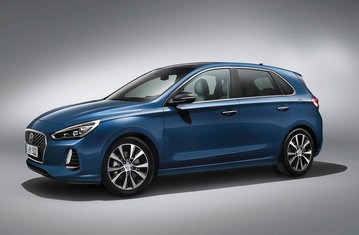
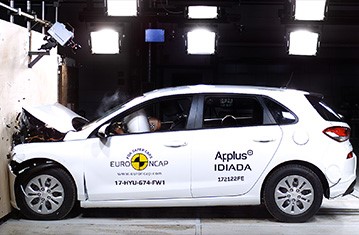

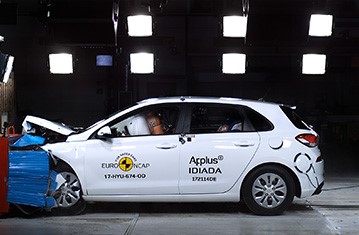

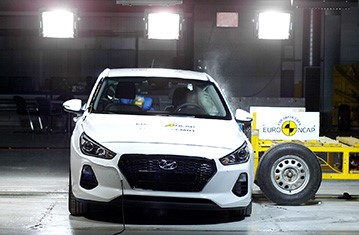
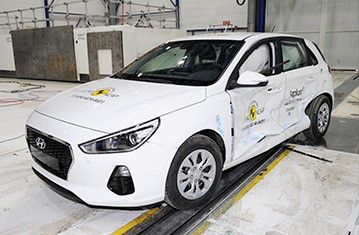
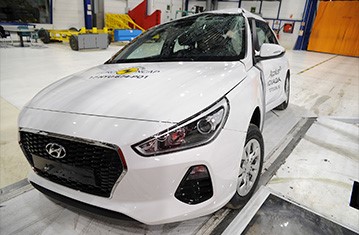



The passenger compartment remained stable in the frontal offset impact. Dummy readings from the driver's knee indicated adequate protection. Structures in the dashboard presented a risk of injury to the driver and passenger and protection of the knee/femur/pelvis area was downgraded to marginal. Otherwise, protection of both dummies was good or adequate. In the full-width rigid-barrier test, and also in the side barrier impact, protection of all critical body areas was at least adequate. In the more severe side pole impact, dummy measurements of chest deformation indicated marginal protection for that part of the body. Tests on the front seats and head restraints indicated good protection against whiplash injuries in the event of a rear-end collision. A geometric assessment of the rear seats indicated marginal whiplash protection there. The i30 has, as standard, an autonomous emergency braking system. Tests of the system at the low speeds typical of city driving, at which many whiplash injuries are caused, showed good performance.